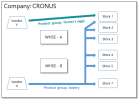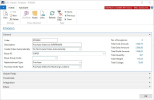

In this scenario the purchased items are delivered directly to the destination stores. This is common for fresh items and bakery items in grocery stores due to limited durability. This is also common for local or regional products for stores with local assortments. Smaller retailers, without warehouses, use this approach also very often.
Replenishment Journals are used to calculate Purchase Order proposals - they need to be set up according to the used item flow.
Goal
The goals of this step:
- Get a detailed understanding on the retailers item-flow approach
- Identify different item-flows for different product groups and stores
- Create an item-flow drawing
- Set up Replenishment Templates and Journals in LS Central
Key questions / considerations
Item Flow related questions:
- Are all items purchased directly to the stores?
- If not:
- Specific product groups or items?
- Items from a specific vendor?
- If not:
- Does this apply to all stores?
- Are there regional differences?
- How frequently are the stores replenished?
- Weekly, Bi-weekly, ... ?
- Specific week days?
Output
Item-flow drawing (see example here)
Template list (see example here)

Setup considerations
Replenishment Templates and Journals
Replenishment Journals are used to calculate Purchase Order proposals for Replenishment.
Each Journal has a Template and a Batch:
- The Template defines what and how the Journal should calculate - it defines the item flow and provides filters for items, stores, vendors, and more.
- The Batch defines when the Journal should be calculated.
For the Vendor to Store approach we create Templates with the following setting:
- Replenishment Type is set to Purchase
- Purchase Order Type is set to Purchase Orders for Receiving Locations to define this item flow approach
- Location Code remains blank
If we detected in the analysis that not all items or stores are using this approach, we need to filter the Template to the desired items and locations. The Template provides filters for:
- Vendors
- Item based filters (Division, Item Category, Product Group, Special Group, ...)
- Store based filters
The calculation frequency is set up in the Replenishment Batch. If stores are replenished on different days, then it is best practice to create multiple Templates which contain stores with the same interval. For example: stores A and B are replenished on Monday and Thursday, store C is replenished on Wednesday only. We would create two Templates with filters for the stores and set up the batches to reflect the frequency.
More information can be found here:
If multiple buyers or buyer groups work with Replenishment Journals and Templates it is good practice to split up the results of the Replenishment calculation into groups that follow the department structure. This is done by filtering the Replenishment Templates.
For example:
- For the purchase part, Templates are very often split into individual Templates per vendor. Furthermore, Buyer and Buyer Groups are also a separation criteria.
- For the transfer part, Templates are very often split by stores or store groups that are replenished in the same interval. Buyer and Buyer Groups are also a separation criteria.
Go back to:


